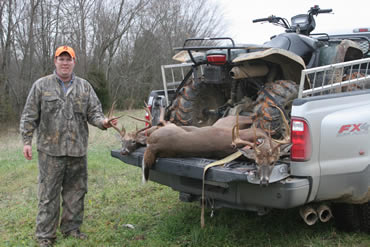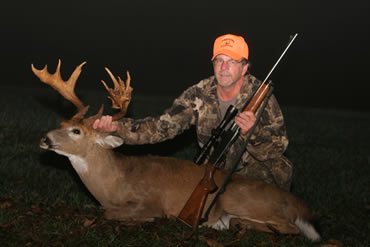If success rates are relatively low, why do we even have buck limits?
In 2007, the Alabama Department of Conservation and Natural Resources changed a long-standing tradition when it reduced the state’s bag limit from a buck a day to three per season. The reason, according to deer studies project leader Chris Cook, was to shift pressure away from bucks to antlerless deer and increase the average age of the bucks in the herd. Cook admits, however, that hunters were already embracing quality deer management — shooting fewer young bucks and more does.
So why do some states even have buck limits? As deer numbers continue to rise throughout much of the Southeast and hunter numbers slide or remain stable, it might seem pointless to restrict hunters to a certain number of bucks, especially when they aren’t filling all their available tags. A whopping 63 percent of Georgia hunters, for instance, didn’t kill a buck in the 2008 season. Just over 10 percent tagged the season limit of two bucks. Half of Virginia’s deer hunters also failed to take a buck.
However, those numbers don’t tell the entire story. Of those hunters who take at least one buck, many tag multiple bucks. Six percent of Virginia hunters killed the legal season limit of three, but they accounted for 42 percent of the state’s total buck harvest.
The numbers are just as staggering in South Carolina, where hunters who kill three or more deer take 44 percent of the total buck harvest.
“Five percent of (Alabama) hunters accounted for 20 percent of the buck harvest,” says Cook. “It wasn’t very common, but I heard of hunters taking 10 or 12 bucks in a single season. We felt the voluntary changes that were resulting in a lower buck harvest weren’t taking place fast enough, so we felt by reducing the season buck limit to three, we would help improve the age structure of our bucks at a faster rate.”
The new rules come at a time when hunters are increasingly practicing self-regulation, shooting more older deer and letting younger ones walk. Although those hunters are doing their part, they also expect state agencies to do their part. That’s why Cook says setting limits on the buck harvest is a sign that game departments are in line with the current wishes of management-minded hunters.
GIVE ’EM WHAT THEY WANT
Surveys conducted by various state wildlife agencies show hunters want their state agencies to step up and increase the overall age structure of the buck herd. Seventy percent of South Carolina hunters, for instance, want the state to impose a limit on bucks where there currently is no season limit. Virginia Department of Game and Inland Fisheries deer project coordinator Nelson Lafon says his agency actually included an unlimited buck option in a survey just to gauge hunter opinion. Biologists had no intention of actually removing the limit, but wanted to find out where hunters stood on the issue.
“There was pretty strong opposition across the board,” Lafon said.
What isn’t so clear, however, is the “right” buck limit. The survey results were broken down by regions, and hunters in some parts of the state wanted a two-buck limit while others were satisfied with the three-buck limit. Just a fraction of the state’s hunters supported raising the limit to four antlered deer, even though half of the state’s hunters don’t even shoot a single buck and just 14 percent kill two.
 Why would they care if the limit was raised above the current number? Lafon says it sends a message to hunters that the agency is making an effort to follow current deer hunting trends of increasing the average age of bucks by taking pressure off them.
Why would they care if the limit was raised above the current number? Lafon says it sends a message to hunters that the agency is making an effort to follow current deer hunting trends of increasing the average age of bucks by taking pressure off them.
Cook agrees the logic behind reducing buck limits has as much to do with public perception as deer management. Although it has certainly helped reduce the buck harvest in Alabama and increased the overall age structure of the state’s bucks, he thinks hunters are happy restrictions are applied to the other guy, the hunter across the fence who might or might not be shooting a pile of bucks.
“Hunters are concerned about others taking more than what is perceived as their fair share of bucks,” says Georgia Department of Natural Resources deer project leader Charlie Killmaster. “In some cases, it can affect hunting. If, for instance, you are careful about limiting your buck harvest, but the guy on the neighboring property is shooting every legal buck he can, it can make a difference to your hunting.”
NEGLIGIBLE EFFECTS
That’s not to say the buck harvest wouldn’t increase some if limits were raised or lifted altogether. Successful hunters, those who actually kill at least one deer, often kill several. Lafon figures if successful hunters had the freedom to shoot more bucks, they would, and the average age structure would likely go down. Arguably, it would have little effect on the overall health of the herd, but many biologists are re-examining age ratios and determining that a large percentage of yearling bucks is not good for deer or deer hunting.
In fact, basic biology suggests that making bucks more vulnerable to harvest will greatly decrease the average age structure. Pennsylvania is a perfect example. Although hunters generally are restricted to one buck per season, pressure has been high for decades, and the buck herd consisted largely of yearling animals. Only through point restrictions adopted in 2002 did the Pennsylvania Game Commission create more balance in the age structure of the state’s buck herd.
 SUPPLY AND DEMAND
SUPPLY AND DEMAND
In some states, buck limits are a simple matter of supply and demand. Kansas, Iowa and Illinois, for example, don’t have the high deer populations typical of the Southeast. That, combined with a high demand from hunters, has forced game managers to restrict the overall buck harvest through limited tag allocations. Iowa Department of Natural Resources deer project leader Tom Litchfield says the current regulations are exactly where they need to be. Although the state is still wrestling with a booming antlerless deer population, the overall quality of the buck herd is close to ideal. But it’s not perfect, which is why some hunters are calling for a reduction in the buck harvest.
“There’s no way we could harvest more bucks and maintain the quality hunting opportunities that Iowa is famous for. We already have more demand for tags than we can offer while continuing to maintain our management goals,” Litchfield says.
If the DNR did raise the number of buck tags it sold — and there’s little to no chance of that happening — there’s no question the average age of bucks harvested would decrease, reducing the overall quality of Iowa bucks.
The same would happen elsewhere, including Ohio, which has a one-buck limit. Ohio Division of Wildlife deer project leader Mike Tonkovich says one of the primary reasons his state has turned into a giant buck factory is the restrictive harvest regulations. When hunters are limited to just one buck per season, many of them tend to be choosy, holding out for a bigger rack and allowing younger bucks to walk. Adding a second tag to the loop would give hunters the ability to change their attitude about buck quality. As a group, they would likely shoot any legal buck regardless of size and then hold out for a big one.
“I can’t say it would actually have much of an impact on the overall health of our deer herd, but it would certainly change the age structure of our bucks,” he said.
WHY NOT ONE?
If places like Ohio, Kansas and Illinois are cranking out high numbers of giant bucks thanks to one-buck limits, why not follow their lead in places like Georgia or Alabama and reduce the limit to just one? Killmaster says comparing the Southeast to the Midwest is like comparing apples to oranges.
“We might protect 15 to 20 percent more bucks by going to a one-buck limit, but what would the benefit be?” he asks. “We have higher deer densities and much more cover than Iowa or Illinois, so we just don’t need to protect more antlered deer.”
Even more telling, surveys have shown the state’s hunters don’t want to reduce the bag limit to a single buck. Although there is a small cadre of hardcore hunters who have asked for a reduced buck harvest, the majority of Georgia’s hunters like the current limit, which places antler restrictions on one of the two allowed per season. Virginia hunters are also satisfied with the current three-buck limit, even though just 6 percent fill all three tags. Hunter desires play a major role in shaping regulations.
KEEP THE PRESSURE ON
Limiting the buck quota in states with high deer populations would likely have another negative effect: It would reduce overall hunting pressure and thereby reduce the antlerless harvest. Hunters who fill their only buck tag early are less likely to continue hunting to shoot does. By providing opportunities to take at least one more buck, those hunters who stay in the woods are also willing to shoot additional does. In fact, Tonkovich says he considered offering a bonus buck tag for hunters who killed two or three does.
“I don’t foresee the need to do something like that any time soon, but it is certainly an idea we’ve considered as an incentive to keep pressure on antlerless deer,” he says.
Generally, biologists agree that buck limits do matter. Regulations are established with all of the data at hand, including the number of deer the average hunter shoots in a typical year along with the total buck harvest. Any change, especially an increase in the bag limit, would have far-reaching implications, not just in the total number of bucks killed, but in the overall age structure.
As more hunters ask for better herd management, it only makes sense to limit the number of bucks harvested.
Read Recent Articles:
• Scoring From Ground Zero: You can’t always find a climbable tree in good whitetail habitat.
• What Jinx? Old Kansas Proverb: Sometimes you get the deer’s goat, sometimes he gets yours.
• Put a Buck to Bed: A look at whitetail bedding areas and how they’re important to hunters.
This article was published in the Winter 2010 edition of Buckmasters Whitetail Magazine. Subscribe today to have Buckmasters delivered to your home.